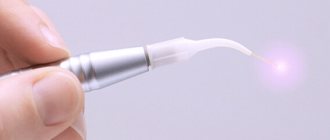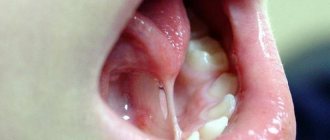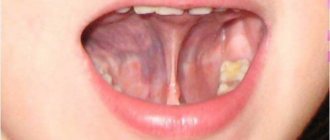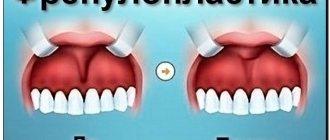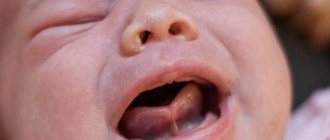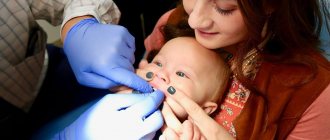Why perform a frenulum trim?
Some violations in the structure of the frenulum lead to quite serious consequences. If there is a short mucous membrane under the tongue, its movement is difficult, which means the patient cannot eat properly, and speech therapy problems appear. In infancy, the baby will not be able to fully suck mother's milk, and therefore the frenulum is cut in the first weeks or months of life.
If trimming the frenulum of the tongue is most often carried out in infancy, then the problems of the short mucous membrane of the lips (usually the upper) may not be so obvious. Shortened and non-elastic films can lead to tension in the gums, a reduction in its volume and exposure of the roots of the front teeth. The consequence of exposure is increased sensitivity of the enamel, pain and active development of caries.
A frenulum that is too voluminous, on the contrary, leads to overhang of the mucous membrane over the surface of the teeth, which primarily affects the aesthetics of the smile.
Thus, the indications for the operation are as follows:
- short bridle,
- disturbances in speech and pronunciation of certain sounds,
- excessive exposure of teeth due to reduction in gum volume,
- problems with nipple latching in babies,
- malocclusion caused by the position of the labial frenulum.
The dentist is able to determine that the frenulum is of incorrect size even when only the first signs appear. In such a situation, an operation to trim the frenulum can help - in infants it takes only a few seconds, does not cause any pain and does not require long-term rehabilitation. This is explained by the fact that the film is still very thin. Adult patients can also undergo a smile correction procedure, but it may involve a longer recovery period and pain, since the mucous membrane is denser and more sensitive to injury. In addition, adult patients experience additional problems in the form of exposed teeth and a reduction in the volume of mucous membranes, which also requires solutions.
Short frenulum of the tongue in a child
Ankyloglossia in children can cause problems with feeding, development of speech function, and development of the dental system. The severity of functional disorders in a child with a short frenulum of the tongue depends on the length and elasticity of the ligament, the place of its attachment, the length and flexibility of the free edge of the tongue.
Difficulties with breastfeeding occur in a quarter of children with a short frenulum of the tongue. In this case, the baby cannot properly latch onto the breast with his mouth, which is why the nipple latch constantly worsens or repeatedly “loses” the breast during feeding. During sucking, characteristic sounds of clicking (clicking) of the tongue appear, restless behavior, and rapid fatigue are noted. At the same time, during one feeding, the baby sucks out a volume of milk that is insufficient for saturation. The consequence of insufficient nutrition is poor weight gain, and in some cases, malnutrition.
Often mothers note that a child with a short frenulum uses his lips to suck, bites or chews the breast with his gums, compensating for the incorrect position of the tongue and trying to increase pressure on the breast. If the child exerts a lot of tension, due to muscle fatigue, he may experience jaw tremors.
The process of feeding a child with a short frenulum of the tongue becomes tiring for mother and baby, and may be accompanied by pain due to injury and cracks in the nipple. Ineffective sucking leads to lactation problems (hypogalactia) because it does not stimulate milk production. In this regard, a child with a short frenulum of the tongue is often transferred to bottle feeding or artificial feeding.
In some cases, even with a short frenulum of the tongue, the baby sucks correctly and receives a sufficient amount of milk. In such children, an anatomical feature in the form of ankyloglossia may appear at an older age, during the period of formation of speech function. A short frenulum of the tongue in a child prevents the correct articulation of sonors ([p], ([p´], [l], [l´]), plucking ([w], [z], [h], [sch]) and others sounds of upper articulation ([t], [t'], [d], [d']). In speech therapy, this condition is regarded as mechanical dyslalia. With a polymorphic disorder of sound pronunciation, the child’s speech becomes illegible and incomprehensible to others.
A short frenulum of the tongue in a child can cause dental problems: open bite, prognathia, displacement of the dentition, the formation of a diastema between the lower front incisors, the development of gingivitis and periodontitis, exposure of the necks and the formation of dental hyperesthesia.
An older child and teenager with a short frenulum of the tongue may be bothered by a cosmetic defect (V-shaped tip of the tongue), constant tears of the frenulum, excessive salivation during speech, aerophagia, snoring and sleep apnea. This problem can leave a negative imprint on self-esteem and give rise to emotional and behavioral problems that require the intervention of a child psychologist.
How is bridle trimming done?
Trimming the frenulum in babies is quick and completely painless, taking only a couple of minutes. In adolescent and adult patients, the operation may take 20-30 minutes. Carrying out laser surgery in a dental clinic by the hands of professionals guarantees the absence of complications and painlessness.
Expert opinion
Dzhutova Aida Vladimirovna Implant surgeon Work experience 10+
“The ability to use painkillers during frenulum trimming depends on the condition of the frenulum, the patient’s age and sensitivity. In children, the film is very thin, so the procedure takes only a few seconds, but in adult patients, anesthesia may be required, since the frenulum becomes denser, and the operation can cause unpleasant and even painful sensations.”
Stages of the operation:
- injection of anesthetic,
- dissection of the frenulum using a laser device, surgical instruments,
- sutures, which usually dissolve on their own 4-5 days after surgery.
At Smile-at-Once, a laser may be used to trim the frenulum. In this case, no anesthesia is required; the laser beam simultaneously carries out antiseptic treatment and stops blood vessels, which prevents bleeding and injury to the mucous membrane.
Additional treatments
After the operation, speech therapy treatment is required to help the child speak and move his tongue again - this will solve all pre-existing speech problems.
If shortened labial mucosa has caused aesthetic problems with the shape of the gums, flap plastic surgery may additionally be performed. Its goal is to form a new gingival contour by cutting and displacing the mucosa.
What to do if a child breaks the frenulum
Children at any age are quite active and mobile. Therefore, injuries are inevitable. Quite often, parents turn to the dentist with the following problem: the baby fell unsuccessfully and tore the frenulum above the upper lip or under the tongue. At the same time, damage to the lower lip is extremely rare due to the fact that normally it is almost not expressed.
If a child cuts the frenulum, then the following signs will be characteristic of such an injury:
- Swelling of the soft tissues in the mouth and above the lip (if the child has torn the upper lip).
- Quite profuse bleeding.
- Pain in the mouth when talking or eating.
In any case, if the baby has torn the mucous fold under the upper lip or under the tongue, you should immediately consult a doctor. It is he who will decide whether such a gap needs to be sutured and will carry out the necessary procedures. Self-treatment can lead to negative consequences: the tissues will not heal properly with the formation of rough scars, which will subsequently lead to an incorrect bite and unclear pronunciation of sounds.
After operation
As a rule, there are no complications after trimming the frenulum of the upper, lower lip or tongue, and recovery takes only a few days. When the operation is performed, it is best to feed the baby immediately, since mother's milk acts as a pain reliever. Adult patients should temporarily avoid hard and sticky foods. If there are problems with speech, then special sessions with a speech therapist are necessary. The slight discomfort caused by the sutures will go away on its own after they are absorbed, that is, after 4-5 days, maximum in a couple of weeks.
What is it and why do we need it?
Such anatomical formations are the thinnest folds of the mucous membrane that connect the mobile lips and tongue with the fixed parts of the oral cavity: the gums and the sublingual space.
In total, there are three frenulums in the baby’s mouth:
- Tongue - located under the tongue.
- Upper lip - localized between the upper lip and the gum mucosa above the level of the central incisors.
- Lower lip - connects the inner surface of the lower lip with the gums at the level of the middle of the alveolar process on the lower jaw.
Despite their small size, such mucous folds are of great importance in human life. In a newborn, they are responsible for proper attachment to the mother's nipple. In older children, the frenulum is involved in the correct pronunciation of sounds and in the formation of a normal bite.
Indications and contraindications for the procedure
Indications:
- Restoring sucking function in infants.
- Speech defects.
- Delayed development of the lower jaw.
- Not chewing food thoroughly.
- Malocclusion.
- Too dense arrangement of teeth or presence of gaps between them.
- Difficulties during orthodontic treatment.
- Preparation for implantation.
Contraindications:
- Poor blood clotting.
- Presence of cancerous tumors.
- Infectious diseases.
- Inflammatory processes in the oral cavity.
- The presence of carious lesions and inflammation of the dental nerve.
If there are problems with breastfeeding, surgery is often performed in the maternity hospital. In older children, the procedure is performed if there are discomfort or problems with diction.
Upper lip frenulum
Even with a simple smile you can see the frenulum of the upper lip, but few people pay attention to it. During a routine examination, the doctor assesses its length; in order to assess the size of the frenulum at home, parents just need to move the baby’s upper lip, and it will become noticeable where exactly the frenulum is woven. In the event that the frenulum is woven between the two front incisors 5–8 mm higher, this is a normal option. If the frenulum is woven below this level, these are obvious symptoms of a shortened frenulum, but the final word always remains with the doctor.
A short frenulum on the upper lip can provoke a violation of the aesthetics of a smile when a gap is formed between the central incisors - a trema, a diastema. It is worth remembering that tremors can be physiological; this period is observed during the period of primary occlusion, when the child’s jaws are preparing for the change of primary teeth to permanent ones. In addition, trems can be pathological, which are formed as a result of some pathology. Treatment of this problem is most often carried out in tandem by a surgeon and an orthodontist.
A short frenulum in a child’s mouth can cause malocclusion, which is formed due to the constant tension of the mucous membrane on the upper jaw and bone tissue. As a result, the front incisors move forward. In addition, such pressure on the mucous membrane provokes inflammation of the mucous membrane - gingivitis. There is a loss of gums, as a result of which the necks of the teeth are exposed and the child develops hypersensitivity of the teeth, and all the conditions are created for the formation of cervical caries.
How does the correction happen?
Treatment of the problem is exclusively surgical, but with one big “BUT”. The frenulum on the upper lip can be corrected only after the eruption of the permanent central incisors, not earlier!!! In some cases, the doctor will recommend adjusting the oral frenulum at the time of the eruption of the permanent lateral incisors - in order to close the gaps between the teeth, such a correction can eliminate orthodontic treatment.
The reason for this ban is very simple. The fact is that during the growth of the jaws, the frenulum on the upper lip can self-correct. That is why there is no point in correcting the frenulum at an earlier age. The correction itself is carried out in a surgical room, under local anesthesia. There are no nerve endings in the mucous cord itself, and therefore the operation is painless; pain relief is necessary when suturing. The operation lasts no more than half an hour and ends with stitches. Thanks to the use of a laser, there is no need for stitches. But there is a certain condition that must be observed after excision of the frenulum: the little one must immediately be attached to the chest.
